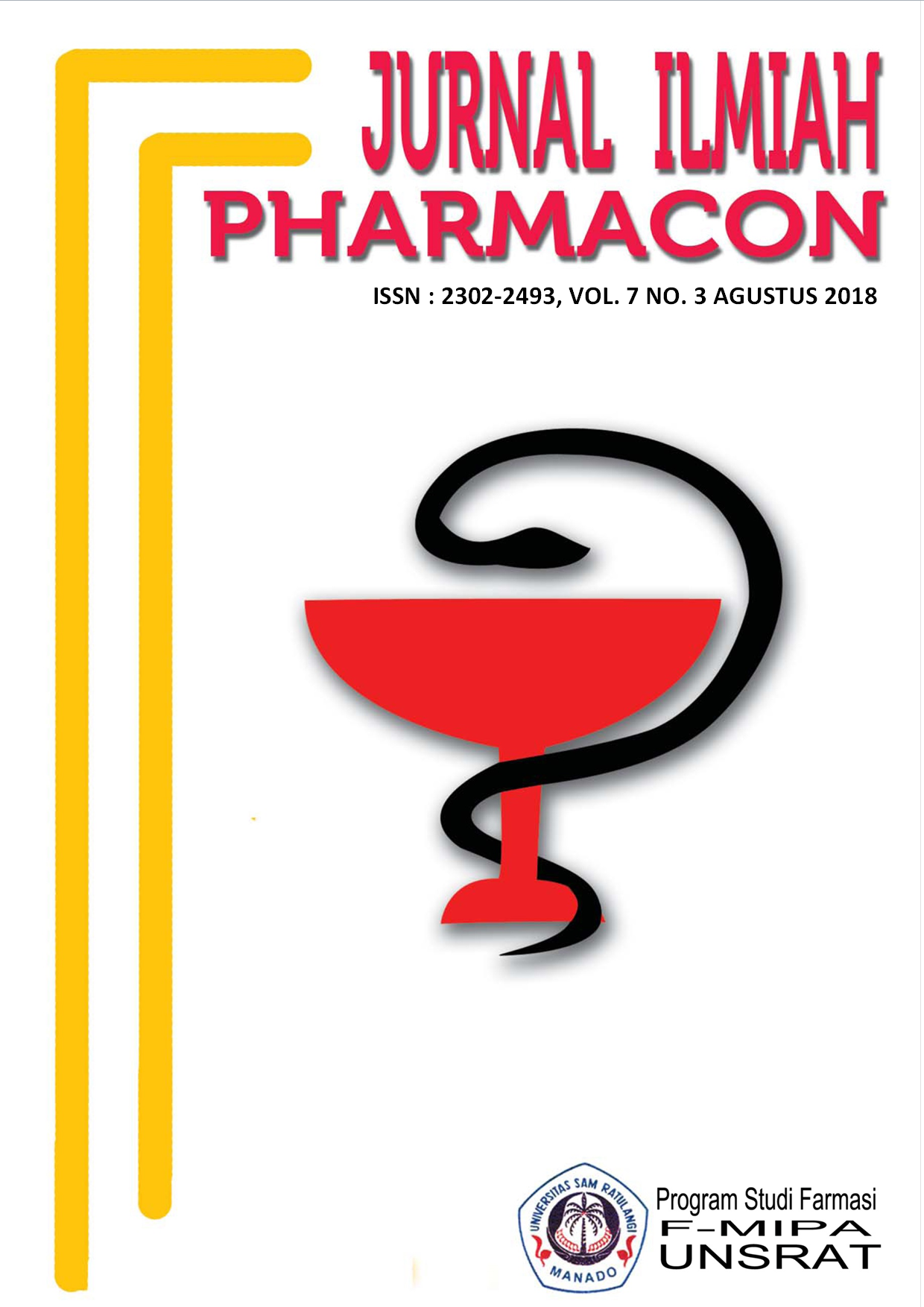PENGUJIAN AKTIVITAS ANTIBAKTERI DAN IDENTIFIKASI SECARA MOLEKULER MENGGUNAKAN GEN 16S RRNA BAKTERI SIMBION ENDOFIT YANG DIISOLASI DARI ALGA MERAH (Galaxaura rugosa)
DOI:
https://doi.org/10.35799/pha.7.2018.20570Abstract
PENGUJIAN AKTIVITAS ANTIBAKTERI DAN IDENTIFIKASI SECARA MOLEKULER MENGGUNAKAN GEN 16S RRNA BAKTERI SIMBION ENDOFIT YANG DIISOLASI DARI ALGA MERAH (Galaxaura rugosa)
Muhammad Zulkifli Hamzah 1), Herny E. I. Simbala1), Adithya Yudistira1)
1)Program Studi Farmasi FMIPA UNSRAT Manado, 95115
ABSTRACT
Endophytic bacteria are defined as bacteria that colonize healthy plant tissue without causing significant damage to the host. Several studies have shown that certain endophytic bacteria can produce chemical compounds that have health effects, especially antibacterial-producing compounds. The aim of this study was to obtain endophytic bacteria from red algae Galaxaura rugosa, to test the antibacterial activity of isolated endophytic bacterial against pathogenic bacteria Escherichia coli and Staphylococcus aureus, and to identify the species of endophytic bacteria that have the highest antibacterial activity based on molecular analysis using encoding gene of 16S rRNA. Bacterial isolation was performed by dilution method. Three isolates were inoculated based on morphological differences. Testing of antibacterial activity was tested by agar diffusion method. Endophytic bacterial isolate that have the highest antibacterial activity is K2 isolate which categorized as intermediate against Staphylococcus aureus and categorized as strong against Escherichia coli. The result of molecular idenfitication shows that K2 isolate has 99% similarity with Bacillus thuringiensis, Bacillus anthracis, Bacillus cereus, and Bacillus mycoides. After multiple sequence alignment and phylogenetic analysis, K2 isolate can be identified as Bacillus mycoides.
Keywords: Endophytic Bacteria, Galaxaura rugosa, Staphylococcus aureus, Escherichia coli, 16S rRNA Gene.
ABSTRAK
Bakteri endofit didefinisikan sebagai bakteri yang menjajah jaringan tanaman yang sehat tanpa menimbulkan luka yang nyata pada inang. Beberapa studi menunjukkan bahwa bakteri endofit tertentu dapat memproduksi senyawa kimia yang memiliki efek bagi kesehatan, terutama senyawa penghasil antibakteri. Penelitian ini bertujuan untuk memperoleh bakteri endofit dari alga merah Galaxaura rugosa, menguji aktivitas antibakteri dari isolat bakteri endofit tersebut terhadap bakteri patogen Escherichia coli dan Staphylococcus aureus serta mengetahui spesies bakteri endofit yang memiliki aktivitas antibakteri terbesar berdasarkan analisis secara molekuler dengan menggunakan gen penyandi 16S rRNA. Isolasi bakteri dilakukan dengan metode pengenceran. Tiga (3) isolat diinokulasi berdasarkan perbedaan morfologi. Pengujian aktivitas antibakteri diuji dengan metode difusi agar. Isolat bakteri endofit yang memiliki daya antibakteri terbesar yaitu isolat K2 yang dikategorikan sedang terhadap Staphylococcus aureus dan kuat terhadap Escherichia coli. Hasil identifikasi molekuler menunjukkan bahwa isolat K2 memiliki kesamaan 99% dengan Bacillus thuringiensis, Bacillus anthracis, Bacillus cereus, dan Bacillus mycoides. Setelah dilakukan multiple sequence alignment dan phylogenetic analysis, isolat K2 dapat diidentifikasi sebagai Bacillus mycoides.
Kata kunci: Bakteri endofit, Galaxaura rugosa, Staphylococcus aureus, Escherichia coli, Aktivitas antibakteri, Gen 16S rRNA
Downloads
Published
How to Cite
Issue
Section
License
Authors who publish with this journal agree to the following terms:
- Authors retain copyright and grant the journal right of first publication with the work simultaneously licensed under a Creative Commons Attribution-NonCommercial 4.0 International License that allows others to share the work with an acknowledgement of the work's authorship and initial publication in this journal.
- Authors are permitted and encouraged to post their work online (e.g., in institutional repositories or on their website) prior to and during the submission process, as it can lead to productive exchanges, as well as earlier and greater citation of published work (See The Effect of Open Access)










